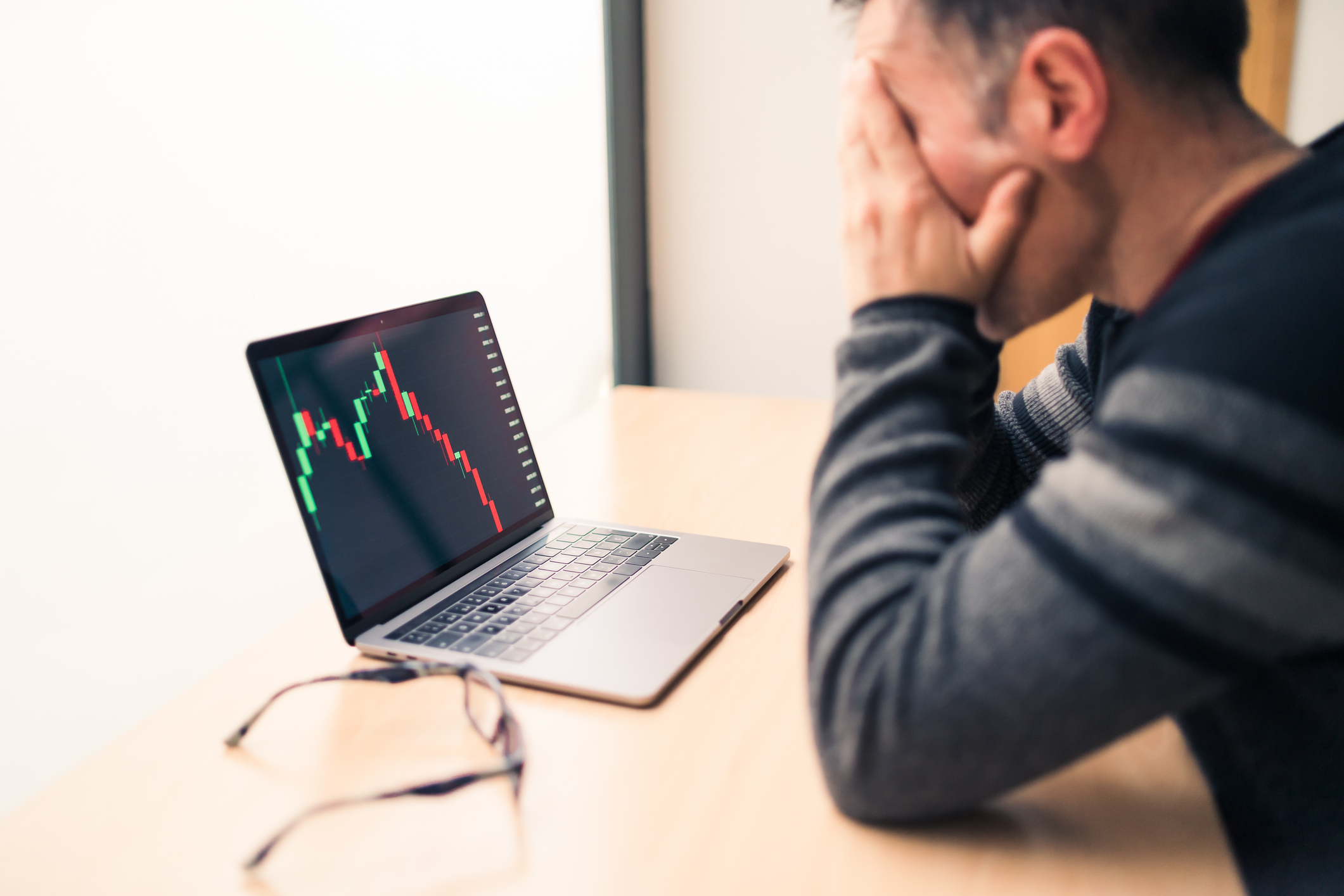How to Protect Your 401(k) in a Down Market: Seven Solutions
If you dread checking your 401(k) in a down market, use these seven strategies to safeguard your nest egg when volatility strikes.


It’s hard to fight that sinking feeling when you check your 401(k) in a down market.
Any time the stock market heads south, as it did in mid-March and early April when the S&P 500 slumped nearly 19% and narrowly avoided a bear market amid trade war worries due to President Donald Trump’s tariff policy, your 401(k)-account balance starts shrinking.
While there’s no way for investors who own stocks and bonds to avoid short-term losses when market volatility strikes, there are plenty of ways to buffer your portfolio from the brunt of the market storm and keep your retirement savings plan on track.
From just $107.88 $24.99 for Kiplinger Personal Finance
Become a smarter, better informed investor. Subscribe from just $107.88 $24.99, plus get up to 4 Special Issues

Sign up for Kiplinger’s Free Newsletters
Profit and prosper with the best of expert advice on investing, taxes, retirement, personal finance and more - straight to your e-mail.
Profit and prosper with the best of expert advice - straight to your e-mail.
What you don’t want to do when stock prices go into freefall is push the panic button and make hasty investment decisions that could do more harm than good to your nest egg.
“What investors should do is remind themselves that they should not allow their emotions to be their portfolios’ worst enemy,” says Sam Stovall, chief investment strategist at CFRA Research.
Market scares, of course, occur from time to time, reminding investors that stocks don’t always go up. Sometimes, downdrafts come out of the blue.
Wall Street, for example, was caught off guard after the market close on April 2 when Trump announced far higher tariffs on U.S. trading partners that investors expected, sending the Dow Jones industrial average down 1,679 points and the S&P 500 and Nasdaq down almost 5% and 6%, respectively, on April 3.
That was also the case in late January when megacap technology stocks and artificial intelligence leaders went into freefall after China’s DeepSeek, an AI platform that is said to operate more efficiently with significantly lower chip and energy demands, put into question U.S. leadership in AI. In a two-day slide on Jan 24 and Jan. 27, the tech-heavy Nasdaq composite slid 3.1%, and the broad S&P 500 fell 1.7%.
On March 13, uncertainty about the economic hit to the U.S. caused by Trump’s tariffs sent the S&P 500 spiraling down to its first official correction (a decline of 10% from a prior high) since October 2023. The broad market gauge bottomed on April 8 at 4982.77, or 18.9% below its February 19 closing high of 6144.15, narrowly averting a bear market, or a drop of 20% or more from a previous high.
The problem with getting spooked by market drops is that they aren’t that unusual and don’t last too long. “Market downturns are normal; they’re going to happen,” says Catherine Irby Arnold of U.S. Bank Private Wealth Management.
Market “pullbacks,” or drops of 5% to 9.99%, have occurred three times per year on average since the 1930s, according to BofA Global Research.
“Corrections,” or declines ranging from 10% to 19.99%, aren’t that uncommon either, despite the fear and angst they cause. A correction such as the one suffered by the S&P 500 from its February 19 record closing high through its April 8 low, typically occurs once a year, BofA says.
Fortunately, dreaded bear markets, or scarier drops of 20% or more, occur less frequently for the broad S&P 500.
401(k) in a down market? Don't panic.
What investors must wrap their heads around to keep their anxiety and fear in check — and avoid the costly mistake of selling at the bottom in fear and missing the subsequent recovery — is the fact that the market tends to recover more quickly than people might think.
Prior to the S&P 500’s latest correction, there have been 101 declines ranging from pullbacks to bear markets since World War II, according to CFRA Research.
“But the amazing thing is the speed it takes to get back to break even,” says Stovall.
On average, it has taken 46 days, or a month and a half, for the S&P 500 to recover fully from pullbacks, according to CFRA. The market has recouped its losses after the 24 corrections since World War II in a tad less than four months.
Garden variety bear markets, or drops of 20% to 40%, take a bit longer to recover from, averaging a little more than a year, or 13 months. The takeaway: It’s a mistake to sell into a downturn. You’re better off buying and holding so you don’t miss the rebound. Investors who got spooked on April 8 and got out of stocks would have missed the nearly 14% rebound.
“Stock market history can serve as ‘Virtual Valium,’ since it can help you sleep better when you know how quickly the market tends to get back to break even from declines,” says Stovall.
Here are seven ways to cushion your nest egg from market declines.
1. Have cash at the ready
Market declines cause the most damage to nest eggs when savers are forced to yank money out of their tax-deferred retirement accounts when stock and other asset prices are depressed.
When you do that, you have to sell more shares to raise the cash you need, and you also lose the growth of your 401(k) holdings once the market recovers.
“You absolutely do not want to have to use your 401(k) as your emergency fund,” says Arnold. “Having cash on hand at all times is a way to smooth out things and avoid having to tap your retirement assets when they are down."
Arnold reminds 401(k) savers that their retirement savings account is a long-term investment. For a young worker in their mid-20s, that means 40 years to both grow their wealth and, more important, plenty of years to recoup losses in any market storm.
“That money is going to sit there for a while,” says Arnold, adding that it’s best to review your 401(k)-account balance on a quarterly or annual basis and not worry about short-term swings.
Of course, savers in or close to retirement should take a more defensive posture to avoid huge market swings that could throw a financial plans off course.
2. Don't put all your dollars in one basket
Diversification, or holding a healthy mix of stocks and bonds in your 401(k) or IRA, is a savior when markets turn rocky.
Having all your money tied up in say, a high-octane technology sector fund or a hot stock such as Nvidia, is great on the upside, but the ride will be scary on the downside. Case in point: the 40%-plus haircut that Nvidia’s shares suffered from its 52-week intraday high of $153.13 on January 7 to its one-year low of $86.62 on April 7.
It’s better to own broadly diversified mutual funds or index funds that track a broad basket of stocks, such as the S&P 500. A short-term loss of 2% or 3% is easier to stomach and recover from than a much larger decline suffered by a single stock.
The fixed-income portion of your portfolio, which consists of bonds, money market funds, CDs and other cash equivalents, will act as a downside buffer against a steep stock market decline.
“At the end of the day, the best thing you can do to position yourself to weather a market downturn is to be very diversified among asset classes based on your risk tolerance and how close you are to retirement,” says Arnold.
In down markets, owning some value stocks rather than betting the farm on high-octane growth stocks, or investing in a total market stock fund that invests in large stocks as well as small and midsize stocks, can add ballast to your portfolio, adds Falko Hoernicke, senior portfolio manager at U.S. Bank Private Wealth Management.
“Those smaller stocks have different risk/return characteristics (than large-company stocks) and can add diversification to a portfolio and still offer return potential,” says Hoernicke. “Value stocks, thanks to lower valuations, tend to be less volatile and have more muted downside since these ‘old economy’ investments have a very stable customer base and resilient and predictable cash flows.”
Divvying up your portfolio using rules of thumb, such as limiting your stock exposure to 110 minus your age, will boost your chances of living through a bear market unscathed, even if you’re in your 50s and 60s.
“If you’re 40, that means 70% of your 401(k) is in equities,” says Stovall. “But if you’re 60, you have just half your money in stocks.” 401(k) plan participants who don’t have the time or savvy to construct their own 401(k) portfolio can invest in a target-date fund, which is professionally managed and determines and regulates the mix of stocks and bonds in the fund by your retirement date, Stovall adds.
3. Invest in dividend-paying stocks
Need income in retirement? A stock market swoon isn’t the best thing for the value of the stocks you own. But it won’t impact the stream of income you earn from stock dividends, says Stovall.
“If you’re somebody who needs to live on the income from your investments, well, unless the company starts slashing their dividend, it doesn’t really matter what the share price of the stock is because you are paid on the number of shares that you own,” says Stovall. “Your income stream remains unaffected.”
Erin Kolo, manager, PWM Equity & Fixed Income at Baird, adds that many value stocks — including dividend payers — “can be helpful in mitigating volatility in a down market.”
4. Don't ignore valuations
It’s easy to ignore valuations, or the price investors are willing to pay for a stock based on things such as earnings or sales. With the market now in year three of a bull market, valuations aren’t cheap. While high price-to-earnings (P-E) ratios have historically been a poor market-timing tool in the short term, they can matter more over the long term, says Kolo.
At the end of the first quarter, the S&P 500 was trading at 22.1 times its expected earnings for calendar year 2025, according to S&P Dow Jones Indices. That’s higher than the 19.4x earnings multiple since 1998.
Be cognizant of the market’s valuation, and if it’s on the pricey end, consider adjusting your holdings and portfolio accordingly to mitigate downside risk in the event of a market correction or bear market.
5. Have dry powder to scoop up bargains
Market downturns don’t always have to be a bummer. When stock prices are down, as they were in early April when tariff anxiety was at its peak, it’s an opportunity to buy shares when they’re cheaper and benefit from their recoveries over the long haul.
“Downturns should be welcomed because you know you’re going to be buying more shares when prices are depressed,” says Arnold.
This buy-the-dip strategy can be executed using available cash, rebalancing your portfolio to keep your stock and bond weightings intact, or simply dollar-cost averaging into the market as you always do with steady contributions into your 401(k) each pay period.
“If you can put more money into the stock market after it’s down 10%, that’s going to be beneficial to you in the long run,” says Arnold.
If you shot yourself in the foot when the market tanked, do things differently next time. In short, learn from your mistakes.
“If you’re brave enough to go back and look at how you reacted to the market at certain times, map things out, and maybe do the opposite next time,” says Arnold.
If you sold at the low in early August, next time you buy the dip and get stocks on sale. Every smart move in a down market can add up to a better chance of enjoying a secure retirement.
6. Keep investing on a regular basis
Market downturns are akin to buying shares on sale, so, don’t fret about falling prices in the short term.
“One of the best times to methodically invest is during volatility, and a down market,” said Ronnie Gillikin, president and CEO of Capital Choice of the Carolinas.
“Consistent investing over time allows participants to buy shares at varying and often lower prices. This is referred to as dollar-cost averaging," Gillikin says. "Buying low is a good thing. Think of it as getting stock on sale. This gives the investor more shares, and they will benefit when the price per share goes up.”
7. Rebalance your portfolio to stay on course
A market drop might be an opportune time to get your asset mix back to where it needs to be and help you more consistently buy low and sell high.
Let’s say your financial plan calls for a mix of 60% stocks and 40% bonds. A nearly 20% drop in stocks might bring your stock weight down to 55%.
Selling some bonds and buying stocks at lower prices to get back to your 60% equity weighting is a strategy that allows you to maintain your asset mix intact and also buy stocks when they’re at depressed prices.
“Rebalancing the assets in a 401(k) regularly can help avoid some of the bigger reductions in the account’s value,” says Gillikin. “Rebalancing can help smooth out the ride and give you confidence during market volatility.”
Read More
Profit and prosper with the best of Kiplinger's advice on investing, taxes, retirement, personal finance and much more. Delivered daily. Enter your email in the box and click Sign Me Up.

Adam Shell is a veteran financial journalist who covers retirement, personal finance, financial markets, and Wall Street. He has written for USA Today, Investor's Business Daily and other publications.
-
 What You Need to Do With Your 401(k) Before 2025 Is Over
What You Need to Do With Your 401(k) Before 2025 Is OverBefore 2025 ends, check your 401(k) contributions, investments, and catch-up eligibility to lock in this year’s tax savings and employer match.
-
 3 Year-End Tax Moves You Can't Afford to Miss
3 Year-End Tax Moves You Can't Afford to MissDon't miss out on this prime time to maximize contributions to your retirement accounts, do Roth conversions and capture investment gains.
-
 A Tax Diversification Strategy for Your Retirement Income
A Tax Diversification Strategy for Your Retirement IncomeSpreading savings across three "tax buckets" — pretax, Roth and taxable — can help give retirees the flexibility to control when and how much taxes they pay.
-
 I'm a Tax Attorney: These Are the Year-End Tax Moves You Can't Afford to Miss
I'm a Tax Attorney: These Are the Year-End Tax Moves You Can't Afford to MissDon't miss out on this prime time to maximize contributions to your retirement accounts, do Roth conversions and capture investment gains.
-
 I'm an Investment Adviser: This Is the Tax Diversification Strategy You Need for Your Retirement Income
I'm an Investment Adviser: This Is the Tax Diversification Strategy You Need for Your Retirement IncomeSpreading savings across three "tax buckets" — pretax, Roth and taxable — can help give retirees the flexibility to control when and how much taxes they pay.
-
 I'm Retired With $2.2 Million Saved and Work 2 Retail Shifts a Week for Fun. My Young Colleague Just Got Her Hours Cut. Should I Quit So She Can Have My Shifts?
I'm Retired With $2.2 Million Saved and Work 2 Retail Shifts a Week for Fun. My Young Colleague Just Got Her Hours Cut. Should I Quit So She Can Have My Shifts?Should she quit her job so a struggling young colleague can take her shifts? We asked certified financial planners for advice.
-
 Could an Annuity Be Your Retirement Safety Net? 4 Key Considerations
Could an Annuity Be Your Retirement Safety Net? 4 Key ConsiderationsMore people are considering annuities to achieve tax-deferred growth and guaranteed income, but deciding if they are right for you depends on these key factors.
-
 I'm a Financial Pro: Older Taxpayers Really Won't Want to Miss Out on This Hefty (Temporary) Tax Break
I'm a Financial Pro: Older Taxpayers Really Won't Want to Miss Out on This Hefty (Temporary) Tax BreakIf you're age 65 or older, you can claim a "bonus" tax deduction of up to $6,000 through 2028 that can be stacked on top of other deductions.
-
 I'm a Financial Pro Focused on Federal Benefits: These Are the 2 Questions I Answer a Lot
I'm a Financial Pro Focused on Federal Benefits: These Are the 2 Questions I Answer a LotMany federal employees ask about rolling a TSP into an IRA and parsing options for survivor benefits, both especially critical topics.
-
 5 RMD Mistakes That Could Cost You Big-Time: Even Seasoned Retirees Slip Up
5 RMD Mistakes That Could Cost You Big-Time: Even Seasoned Retirees Slip UpThe five biggest RMD mistakes retirees make show that tax-smart retirement planning should start well before you hit the age your first RMD is due.
-
 I'm a Wealth Adviser: My 4 Guiding Principles Could Help You Plan for Retirement Whether You Have $10,000 or $10 Million
I'm a Wealth Adviser: My 4 Guiding Principles Could Help You Plan for Retirement Whether You Have $10,000 or $10 MillionRegardless of your net worth, you deserve a detailed retirement plan backed by a solid understanding of your finances.